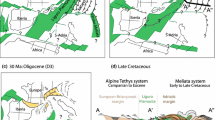Abstract
Along-arc variation in the geometry of the décollement surface at a convergent margin is one of the significant parameters to assess the likely magnitude of a major/great earthquake. It is linked to the crustal/lithospheric structure and pre-existing tectonic fabric of the underthrusting plate. For the Himalayan collision belt, segmentation of the Indian lithosphere along the arc has been suggested based on seismological and GPS studies, and by analysis of topography and Bouguer gravity anomaly data. These studies, confined to the Himalaya-Tibet region, linked major segmentation boundaries to three transverse ridges in the Ganga basin. Since the formation of the Indo-Gangetic foreland basin is also controlled by the thermomechanical properties of the underthrusting Indian plate, in the present work, we study the Himalaya-foreland basin system for possible segmentation of the Indian lithosphere. We analyse the foreland basin width vis-à-vis the disposition of major thrust faults along several profiles cutting across the Himalayan arc to test a possible correlation between these two parameters. The results suggest a major segmentation boundary along the Indo-Nepal border in addition to other previously discussed segmentations coinciding with major transverse ridges in the Ganga basin. This segmentation boundary coincides with the Great Boundary fault separating the Aravalli Delhi fold belt (ADFB) from the Vindhyan basin further south. We infer a possible role of this boundary in limiting westward propagation of the rupture front of the 1505 paleo-seismic event and seismicity of the ADFB through coupling between the Himalayan collision belt and the intraplate Indian shield region.
Similar content being viewed by others
References
Adilakshmi, L., Manglik, A., Thiagarajan, S. and Suresh, M. (2021) Crustal structure of the Indian plate underneath the alluvial plains of the central Ganga basin by broadband magnetotellurics. Tectonophysics, v.802, 228746.
Arora, B.R., Gahalaut, V.K. and Naresh Kumar (2012) Structural control on along-strike variation in the seismicity of the northwest Himalaya. Jour. Asian Earth Sci., v.57, pp.15–24.
Bai L., Klemperer, S.L., Mori, J., Karplus, M.S., Ding, L., Liu, H., Li, G., Song, B. and Dhakal, S. (2019) Lateral variation of the Main Himalayan Thrust controls the rupture length of the 2015 Gorkha earthquake in Nepal. Sci. Adv., v.5, eaav0723, doi: https://doi.org/10.1126/sciadv.aav0723.
Boulton, S.J. and Stokes, M. (2018) Which DEM is best for analyzing fluvial landscape development in mountainous terrains? Geomorphology, v.310, pp.168–187.
Bonvalot, S., Balmino, G., Briais, A., Kuhn, M., Peyrefitte, A., Vales, N., Biancale, R., Gabalda, G., Reinquin, F. and Sarrailh, M. (2012) World Gravity Map. Commission for the Geological Map of the World. Eds. BGI-CGMW-CNES-IRD, Paris.
Dal Zilio, L., Jolivet, R. and van Dinther, Y. (2020) Segmentation of the Main Himalayan Thrust illuminated by Bayesian inference of interseismic coupling. Geophys. Res. Lett., v. 47, e2019GL086424.
Dal Zilio, L., Hetényi, G., Hubbard, J. and Bollinger, L. (2021) Building the Himalaya from tectonic to earthquake scales. Nat. Rev. Earth Environ., v.2, pp.251–268.
Demudu Babu, M., Manglik, A., Thiagarajan, S. and Suresh, M. (2020) Electrical resistivity image of a basement ridge in the foreland central Ganga basin. Jour. Appl. Geophys, v.179, 104097.
Elliott, J.R., Jolivet, R., González, P.J., Avouac, J., Hollingsworth, J. and Searle, M.P. (2016) Himalayan megathrust geometry and relation to topography revealed by the Gorkha earthquake. Nature Geosci., v.9, pp.174–180.
Godin, L., La Roche, R.S., Waffle, L. and Harris, L.B. (2018) Influence of inherited Indian basement faults on the evolution of the Himalayan Orogen. Geol. Soc. London, Spec. Publ., v.481, pp.251–276.
Hetényi, G., Cattin, R., Berthet T., Le Moigne, N., Chophel, J., Lechmann, S., Hammer, P., Drukpa, D., Sapkota, S.N., Gautier, S. and Thinley, K. (2016) Segmentation of the Himalayas as revealed by arc-parallel gravity anomalies. Sci. Rep., v.6, 33866.
Krüger, F. and Ohrnberger, M. (2005) Tracking the rupture of the Mw = 9.3 Sumatra earthquake over 1,150 km at teleseismic distance. Nature, v. 435, pp.937–939.
Li, J. and Song, X. (2018) Tearing of Indian mantle lithosphere from high-resolution seismic images and its implications for lithosphere coupling in southern Tibet. Proc. Natl. Acad. Sci., v.115, pp.8296–8300.
Mandal, N., Bose, S., Baruah, A. and Sarkar, S. (2015) First-order topography of the Himalayan Mountain belt: a deep-crustal flow analysis. In: Mukherjee, S., Carosi, R., van der Beek, P.A., Mukherjee, B.K. and Robinson, D.M. (Eds.) Tectonics of the Himalaya. Geol. Soc., London, Spec. Publ., v.412, pp.5–23.
Paul, A., Bhakuni, S.S., Pant, C.C., Darmwal, G.S. and Pathak, V. (2010) Microseismicity in central part of Inner Kumaun Lesser Himalaya: implication to active seismotectonics. Himalayan Geol., v.31, pp.107–115.
Singer, J., Obermann, A., Kissling, E., Fang, H., Hetenyi, G. and Grujic, D. (2017) Along-strike variations in the Himalayan orogenic wedge structure in Bhutan from ambient seismic noise tomography. Geochem. Geophys. Geosyst., v.18, pp.1483–1498.
Valdiya, K.S. (1976) Himalayan transverse faults and folds and their parallelism with the subsurface structures of the north Indian plains. Tectonophysics, v.32, pp.353–386.
Yin, A. (2006) Cenozoic tectonic evolution of the Himalayan orogen as constrained by along-strike variation of structural geometry, exhumation history, and foreland sedimentation. Earth-Sci. Rev., v.76, pp.1–131.
Zhao, J., Yuan, X., Liu, H., Kumar, P., Pei, S., Kind, R., Zhang, Z., Teng, J., Ding, L., Gao, X., Xu, Q. and Wang, W. (2010) The boundary between the Indian and Asian tectonic plates below Tibet. Proc. Natl. Acad. Sci., v. 107, pp.11,229–11,233.
Acknowledgements
We are thankful to Prof. Harsh K. Gupta, President, Geological Society of India, for encouraging us to submit this article to J-GSI. Valuable comments by an anonymous reviewer are gratefully acknowledged. The work has been carried out under the projects MLP-6404-28(AM) and MLP-FBR-0003(AM). CSIR-NGRI contribution number NGRI/Lib/2021/Pub-115.
Author information
Authors and Affiliations
Corresponding author
Electronic Supplementary Material
Rights and permissions
About this article
Cite this article
Manglik, A., Kandregula, R.S. & Pavankumar, G. Foreland Basin Geometry and Disposition of Major Thrust Faults as Proxies for Identification of Segmentation along the Himalayan Arc. J Geol Soc India 98, 57–61 (2022). https://doi.org/10.1007/s12594-022-1928-y
Received:
Accepted:
Published:
Issue Date:
DOI: https://doi.org/10.1007/s12594-022-1928-y




